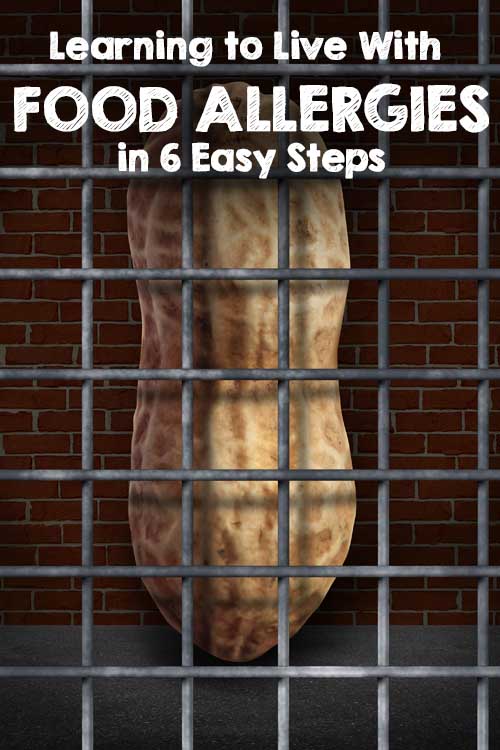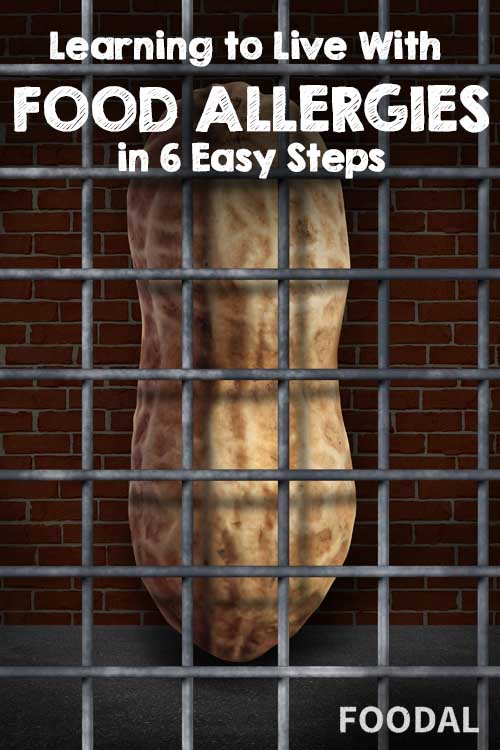Most of us have had food allergies and intolerances touch our lives in some way.
Whether it’s an ad on TV touting the latest gluten-free baked goods, a note from your child’s teacher requesting that you refrain from sending anything that contains peanuts to school, or a recommendation from the doctor who says she wants to do some tests to get to the bottom of your digestive issues, little reminders of the prevalence of food intolerances and allergies seem to be everywhere.
The question is, what do you do when the person with the food allergies turns out to be you, or someone you love?
This is exactly what happened to me. In fact, it happened several times, and led in part to my interest in studying gastronomy in graduate school, and writing about topics related to food allergies and dietary disease today.
Though it’s not always easy, learning to deal with new dietary changes in order to avoid an adverse reaction is not impossible, and it can be very rewarding.
Seriously.
Not only will you feel better, you might discover new favorite foods, restaurants, cookbooks, and even friends in the process!
Read on to find out more about my own story, one that you may be able to relate to. I’ll also share six easy steps that you can take in your journey towards learning to live with food allergies.
Figuring Out Life with Dietary Restrictions
When I was growing up, I knew what it was like to sometimes shop at the health food store, reading labels closely, and occasionally eating meals that included different foods for different people.
I also knew what it was like to spend a lot of time in the bathroom, or to wait while others spent a lot of time in the bathroom after a meal…
Though other friends and family members had various known intolerances – like lactose intolerance, which seemed to suddenly become super prevalent among friends and relatives as I got older – my mom’s dietary needs were certainly the most restrictive.

In addition to several other types of food intolerances, my mom has celiac, an autoimmune disease that makes it impossible for those who have it to digest wheat gluten.
I learned to cook for my mom starting at a very young age, and this understanding of what special diets could mean for different people made it easier for me when I was going through my own “dietary journey.”
Saying Goodbye to Tom Yum Soup
About seven years ago, I received a voicemail from the doctor:
“Your bloodwork shows a shrimp allergy so, uh… you should avoid shrimp.”
Huh. Really?
Not only did I find the doctor’s lack of specificity here a bit alarming, a shrimp allergy was definitely the furthest thing from my mind when I started visiting this new physician, in pursuit of relief from the digestive difficulties and reactions that had plagued me on and off for years, and that had never truly been resolved.

No one else in my family had a shrimp allergy, and I was left with so many questions:
- Did this mean I might have to avoid other types of shellfish, or perhaps avoid seafood altogether?
- Did this explain why I had gotten so sick that one time at the local Thai restaurant, between my first and second courses, while I was still sitting at the table?
- Would this be easy to deal with and adjust to, since I didn’t usually eat shrimp very often, or more difficult, since I wasn’t sure how severe this might be?
That short voicemail from the doctor didn’t give me any answers.
Fortunately, thanks to my experience, I already knew what steps to take next.
Read on and you will, too!
A Diagnosis Is Just the Beginning
In 2010, it was estimated that 12 million Americans had food or digestive allergies.
More recent studies estimate that up to 32 million people in the US have food allergies today, and scientists are still trying to figure out why exactly this might be.
Despite the prevalence of allergies and intolerances today, all of us are filled with questions when we, or someone we love, is diagnosed with a food-related illness.
Questions like these have gone through my head many times, and they’ll go through yours too, if they haven’t already:
- What will we eat from now on?
- What should we cook for dinner?
- Can we still enjoy dinner as a family?
- Can we dine out with friends?
- How will we celebrate food-focused holidays, like Thanksgiving, Christmas, or Halloween?
- Will eating ever be fun again?
Though the news of a food allergy may seem devastating at first, these issues are something that most people are at least somewhat aware of these days, and that makes them much easier to deal with than it once was.
Just a few decades ago, very few people knew what it meant to be on a “gluten free” diet, or “lactose intolerant.”
Today, many restaurant employees are given food allergy training, many people can rattle off the FDA’s list of common allergens, and reading labels at the grocery store is nothing to scoff at.
Common Allergens: Can You Name Them All?
Now is probably a great time to go into a little more detail about the common ingredients that affect the most people in the United States.
Can you name all eight?
In 2004, the FDA made it mandatory for manufacturers to identify whether any of the eight most common allergens in the US are found in their products.
These ingredients are:
Though allergies to about 160 different ingredients have been documented, the eight items listed above are the most prevalent in the US. As of January 1, 2023, the list will be expanded to also include sesame.

In other countries the prevalence of allergies to certain foods differs, just as diets differ. For example, mustard and celery allergies are much more common in Europe than they are here in the US.
Food Allergies: The Real Deal
Though the severity of adverse effects of consuming these foods can change with time and some allergies can actually be outgrown, others don’t become apparent until adulthood.
Food intolerances are different from allergies because they don’t involve an immune response. Even so, they can still cause uncomfortable symptoms like stomach cramps, and they can still result in a recommendation to avoid certain items in order to alleviate and prevent unwanted symptoms.
Food allergy and intolerance symptoms can vary depending on the allergen, the severity, and the person.
These symptoms include rashes and hives, digestive difficulties including vomiting and nausea, wheezing and difficulty breathing, throat and mouth swelling, and even a loss of consciousness or anaphylaxis.
Different tests can be performed to determine the presence of food allergies or intolerances, including blood tests, skin prick tests and food challenges, the latter of which involves actually consuming the food in question under the observation of a doctor to check for a reaction.
The problem is, the results of some of these tests can be confusing and sometimes misleading.
An IgE blood test looks for Immunogloblin E, an antibody that the body sometimes makes in response to certain foods. The thing is, the presence of these antibodies doesn’t always indicate an actual allergic response, and the level of the antibodies doesn’t always correspond to the severity of an allergy.
The same goes for skin prick tests – a red welt that shows up on the surface of a patient’s skin when the test is administered by an allergist doesn’t always indicate what will happen if a person eats this particular type of food.
Weeding out the culprits that may be causing skin rashes, congestion, an upset stomach, and other symptoms can be an arduous process, leaving allergy sufferers and their parents and other loved ones feeling as if eating a “normal” meal has become impossible.
At times, food allergies can be more severe, resulting in potentially life-threatening symptoms like anaphylaxis.
Though this is rare, it’s common for those who are already aware of food allergies that they have or that family members have been diagnosed with to wonder whether their own intolerances could be more severe.
Some individuals need to carry an epinephrine injector that can be used in the case of an anaphylactic reaction. Those who have severe, life-threatening reactions often carry one of these in case of accidental exposure to allergens like peanuts or shellfish.
Elimination diets can be frustrating, and the fear associated with being on constant alert in order to maintain your new diet can take the fun out of eating.
Fortunately, there are steps that you and your family members or housemates can take to make your meals enjoyable again.
Tips for Traversing the Food Allergy Landscape
Even if this is all new to you and all of the things that I just mentioned seem totally foreign and strange and maybe even a bit scary, don’t worry! You will learn, and you will adjust.
Eating really can be fun again!
6 Easy Steps to Help with the Process
As promised, here it is, in six easy steps that will help you to learn more, cope and adjust, and start loving your food again.
Step 1: Ask Questions
When I received that call from my doctor, so much was left unsaid. I wasn’t sure what else the doctor had tested for, how severe my allergy was, and if I might be sensitive to other types of shellfish as well.
So here’s what I did:
I called the doctor.
When it comes to food allergies and intolerances, information is power.

If you, a family member, or someone that you are preparing a meal for has a known food allergy, you need to be informed in order to know how to deal with it.
Everyone has to eat, and although reactions that quickly become life-threatening after accidental exposure are rare, it’s important to know how to deal with these in order to avoid making others sick, or to avoid becoming sick yourself.
You might not need to pull out the EpiPen, but no one likes a rash or a stomachache either. Symptoms can vary from one person to the next, but they shouldn’t be ignored.
Make a list of questions to bring with you to the doctor, and voice all of your concerns.
Find a doctor who caters to your specific needs and look beyond your family doctor if you have to, consulting an allergist or specialist.

Your insurance company can help you to locate gastroenterologists, allergists, and dietitians in your area, and your family doctor may be able to help you with recommendations.
When I asked questions, I found out that my shrimp allergy was a level 2 out of 5. I was also tested for a response to clams and scallops, types of mollusks, and I showed no reaction to those.
I was not, however, tested for sensitivity to crab or lobster, which are types of crustaceans.
Because crustaceans share a similar type of protein with shrimp that can bring about a reaction in some people, I discussed further testing with my doctor as well.
Step 1A: Asking Questions for Kids
It’s important to teach children who are diagnosed with food allergies at a young age to ask lots of questions, too.

You don’t need to scare them, but you do need to let them know what it means when the doctor decides that they need to avoid eating certain foods, so they won’t become sick.
Teach them to ask about the ingredients and tell them that it is NOT okay to take food from teachers, friends, or classmates unless it’s on their “safe foods” list, or unless they are given permission by a parent first.
Teach kids that a food allergy isn’t something to be embarrassed about. Instead, it’s just something that makes them special, and it’s important that others who are making their meals know about their sensitivities so they won’t get sick.
Sometimes it’s important to explain to your kids that no one will be upset if they refuse a certain dish due to their allergies, and that they don’t need to be afraid of facing situations where they cannot eat the meal choice that is being offered.
Adults and children with food-related allergies will need to learn to carry snacks and explain their special needs when it comes to meal selection.
Also be sure to inform your child’s school and any caretakers of your child’s special meal requirements, and exactly what they entail.
Step 2: Learn to Adapt Recipes and Seek Out New Ones
For those who have just been diagnosed with food allergies or intolerances, it can seem as if there’s suddenly nothing that you can eat.
This can be really discouraging if, like me, and like so many of us at Foodal, you’re someone who really enjoys food and cooking.
Since food allergies are on the rise, they’re a hot topic. And this is great for you, since it means you’ll be able to find tons of cookbooks, magazines, memoirs, and blogs written by others who are on their own personal food allergy journeys, and who are looking to eliminate certain ingredients from their diets in a fun and delicious way.

I’ve found books and blogs that focus on substitutions to be especially helpful.
Knowing a little bit about the chemistry of food can be very useful here, and it’s fascinating to learn about what ingredients can replace an egg in baking, and which types of non-dairy milk might not hold up in certain dessert recipes.
Beginning with recipes that are written specifically for people who are avoiding certain ingredients is far less complicated than attempting to research and come up with substitutions on your own.
To take the hassle out of adapting to your new way of eating, I recommend starting with recipes that specifically cater to your own special diet first, and then branching out to try making some of your favorite recipes using ingredient substitutions that cater to your new special diet. Dietitians can help to make recommendations as well.
You’ll find lots of resources that can help you to navigate the new world of cooking and eating without peanuts, dairy, eggs, wheat… whatever it is, someone is probably already writing about it, and sharing their wisdom!
You can even join the conversation if you seek out an online cooking or support group that you like that explores the topic.
Maybe you’re not allergic to one of the most common allergens? It might be a little more difficult to find recipes that are tailored to your needs, but not impossible.
If you have a reaction to a particular fruit, vegetable, seed, or spice that does not appear on the top list in the US, substitutions in basic recipes are pretty straightforward and simple to navigate – just try the same cooking technique using a different but similar ingredient, or change up the basic flavor profile while keeping the rest of the ingredients and the cooking method the same.
Step 3: Re-Learn the Grocery Store
This one is so important, especially when it comes to processed foods.
It seems unfair that so-called “convenience” foods, the ones that you can just eat right out of the package, stick in the oven, or pop in the microwave are the products that you’re going to have to spend the most time examining before you give them the green light.

This is because processed foods contain added flavorings, starches, stabilizers, and other ingredients to get the texture, color, flavor and shelf-stability just right. And these ingredients can sometimes be hidden sources of allergens.
Fortunately there are convenience foods today designed just for those with certain intolerances in mind. But it remains important nonetheless to always remember to read the label.
When you’re first diagnosed with an allergy, you might find it helpful to bring a list of ingredients to avoid with you to the grocery store.
Or, choose the recipes that you’d like to try for the week before you go shopping, and bring a “safe list” to the store with you instead – just remember to focus only on these items, resisting the urge to toss other things into your cart without close examination.
Shopping for groceries online can help immensely with this, since you won’t be as tempted to buy add-on items that weren’t on your list. Most online sources allow shoppers to view lists of ingredients for each item, taking away the pressure that sometimes comes with standing in front of a fully stocked shelf or alongside others in a rush to gather their groceries.
To take the hassle out of grocery shopping in a big way, you might even consider switching to a whole foods diet or cooking from scratch. Major allergens in their whole form as well as hidden ingredients are easiest to avoid in this way.
Fruits and vegetables don’t need labels for a good reason – because you can see exactly what they are!
Foods with fewer ingredients on the label are less processed, and their contents are more straightforward, perfect for anyone with allergies or intolerances who is trying to make the best choices at the store.
Depending on the severity of your allergies and the changes to your diet that are required, you may want to go through your refrigerator, pantry, and cabinets before you even head out to do your shopping, tossing or donating anything that contains ingredients on your “forbidden foods” list, or setting those items aside for someone else within your household.
Step 4: Avoid Cross-Contamination
When you’re cooking at home in your own kitchen, there might be others in the family who are still permitted to eat things that you’ve been told to eliminate from your diet.
If this is the case, you need to avoid accidentally exposing yourself to these allergens.
This might mean using your own set of utensils and appliances – such as your own wheat-free toaster, like my mom uses – or preparing two pots of pasta or two sauces in different pots, being careful to stir them with separate spoons.
There might be certain items that you cannot touch without breaking out in a rash, so prepping these items should be left up to others.
There may also be cases where you or a loved one is diagnosed with an allergy so severe that your entire household must give up a certain ingredient. This can be hard for everyone at first, but it helps to know that you’re all in this together, and that there are plenty of delicious alternatives available to enjoy, probably more than ever before.
Those who are reluctant to make the adjustment may be able to partake in peanut butter ice cream or shrimp scampi when they’re outside the house, but they need to realize that giving up a particular item at home is a small sacrifice when the health of a loved one is involved.
Step 5: Find or Create a Community
There are others out there like you, with food allergies and intolerances like yours. You just have to find them!

When you have a sick child or you’re worried about your own health, it helps to surround yourself with others who understand, so you can reach out to them for advice or a word of support during those tough moments.
This is one of those cases where the internet can be a wonderful and magical place. You’ll be surprised to discover how many blogs and discussion boards are out there where others just like you are talking about their favorite restaurant finds, school lunch tips, and recipe recommendations. You can commiserate, and you can find joy.
I’ll amend this step with a word of caution:
Do not take medical advice from anyone other than a trained professional, and avoid tumbling down the rabbit hole of self-diagnosis, which it is so easy to do online.
All of the helpful steps provided here assume that you have already been to a doctor and received an official diagnosis that addresses and explains what ails you.
Community can be found in the act of eating as well, beyond the realm of discussion. Commensality, or the practice of eating together, brings with it a special comfort.
In my own life, I recently hosted a surprise birthday party for my mom, with a menu centered entirely around her unique dietary needs. Though special ingredients can sometimes be more expensive, why not share the good eats with everyone, at least on special occasions? And let them see how delicious it can be to eat with certain restrictions.
Our tea party menu for the day included cucumber dill and chicken salad sandwiches, veggie spring rolls with dipping sauce, assorted sparkling drinks and teas, and my mom’s favorite gluten-free orange sponge cake with dairy-free whipped cream. Everything that we enjoyed at the party was gluten-free, lactose-free, and low FODMAP. And everyone loved it!
Whether you are planning a party or a regular meetup where members share potluck offerings that everyone in the group can partake in, finding ways to share meals again while truly enjoying the experience can help to relieve some of the anxiety that often comes with adjusting to a new, restrictive diet. That brings us to our final step on this list…
Step 6: Learn to Enjoy Food Again
For someone who was recently diagnosed with a food allergy, eating can be a scary experience. This is especially true for those who have had the misfortune of experiencing a severe adverse reaction.
At first it can seem as if food, this life-giving stuff that was once so enjoyable, has somehow turned against you.
Everyone needs to eat, so it’s helpful to build a support system and surround yourself with others who understand what you are going through.
If you’re only comfortable eating meals that you have prepared yourself at home at first, that’s entirely fine, and completely normal. This is a great way for you to regain control of the situation, since you’re the one selecting the ingredients and stirring the pot.
As you gain reassurance and start to feel better, you will begin to discover new favorite types of cuisine and favorite dining establishments. And that’s a wonderful thing!
Many restaurants offer allergen-free menu items, and some bakeries and restaurants are completely free of certain ingredients in order to cater to customers with special diets. Seek out these places.

Try hosting an allergen-free meal for family and friends as mentioned above, or get together to do the cooking as a group, so they can learn firsthand how to cook meals that you can enjoy.
This activity will boost everyone’s confidence, and will show those who feel as if they don’t understand your allergy how delicious meals made with food intolerances in mind can be.
It really is rewarding to know that you or your family members with allergies can continue to enjoy special treats once in awhile, just like you used to.
You will find new favorites, and new ways to enjoy treasured family recipes. Sometimes these new adaptations even lead to new creations that were better than what you remember eating before. It takes a little patience to make this new adjustment, but the results will be well worth it.
Time to Start Cooking!
Severe allergies should be taken seriously, but with a little bit of dietary adjustment, the whole family will be eating happily and healthily again.

Your job is to get out there, and start exploring your new diet.
It’s time to read those labels, explore those websites, find those glossy food images that speak directly to you, and start cooking!
I’d love to hear all about your food allergy journey – what have you learned along the way, and what are some of your new favorite recipes or places to eat?
What advice can you share with others who have recently learned that they have certain food allergies or intolerances? Tell me all about it in the comments!
And for more culinary how-to with a focus on special diets and healthy eating, read these guides next:
- White Rice Flour and Sweet Rice Flour: What’s the Difference?
- Can Eating too Many Carrots Turn You Orange?
- Lentils: An Alternative to Soy
© Ask the Experts, LLC. ALL RIGHTS RESERVED. See our TOS for more details. Uncredited photos via Shutterstock. Originally published on December 9, 2015. Last updated on November 29, 2022.
About Allison Sidhu
Allison M. Sidhu is a culinary enthusiast from southeastern Pennsylvania who has returned to Philly after a seven-year sojourn to sunny LA. She loves exploring the local restaurant and bar scene with her best buds. She holds a BA in English literature from Swarthmore College and an MA in gastronomy from Boston University. When she’s not in the kitchen whipping up something tasty (or listening to the latest food podcasts while she does the dishes!) you’ll probably find Allison tapping away at her keyboard, chilling in the garden, curled up with a good book (or ready to dominate with controller in hand in front of the latest video game) on the couch, or devouring a dollar dog and crab fries at the Phillies game.






Food allergies have become more common in recent years. While most people hear about the major ones such as shellfish and peanuts, there are so many more smaller scaled ones. I have a few friends who are allergic to wheat. Not only bread but beer too. When ever they have a beer their nose gets all stuffy and it sounds like they have a cold. It’s not life threatening but they definitely have to be conscious of what they eat and drink.
Good info. I developed a couple of food intolerances around the start of my teen years. Things I had never been allergic to before, suddenly became an issue. Tomatoes were one of them.
I honestly think it is due to the pesticides or something that they use when tomatoes are grown commercially, since I seem to have no problem eating fresh tomatoes from a home garden. It’s definitely something to consider. It may not be the food that is the problem in my case.
I have a lot of experiences with food allergies, although I don’t have any (that I know of) myself. A friend of mine has a brother with a severe peanut allergy, and I learned early on what not to give him. He also had at least three more of the 8 common ones listed. Some of his intolerances have even gone away or gotten less severe over time. Knowing him has made me careful. I also sometimes bake for people, and I always make sure to ask about any known food issues before I start. This is life-saving information.
My significant other has such awful allergies and intolerances. I especially found relearning the grocery store was the hardest thing to do. I also found it difficult to remove some things from my every day diet that he can no longer eat. Great post!
It can be quite frustrating when you find out you have an allergy especially if it’s a food you like. I have quite a few friends whose diet retrict them from having either cheese or chocolates and unfortunately these are foods they love so they have hard times ignoring them.
Fascinating and informative article. I had no idea that you could learn to live with your allergies. I am sure there are many out there who will read this article and benefit from it. Many people will be grateful for your insight.
Thanks, oraclemay- I’m happy to help!
Thank you for these tips. When I was a kid I had a pretty severe food allergy that was very tricky to work around, and my parents weren’t adaptive enough in the kitchen, so it created problems, especially since I loved milk and sweets, and those were a no-no.
Food allergies can be extremely challenging and distressing, especially if it is a child or a fussy eater. I would recommend searching for allergy support groups online, or consulting a dietitian.
Great advice, Cheddar. An allergist can be very helpful as well, by providing the testing that’s required to determine the presence of food and other types of allergies.
Something had to have changed over the years. Me and my siblings had no allergies and we were always healthy. My kids have all kinds of allergies from strawberries to nuts you name it. This cannot just be because of chance or even hereditary. Something has changed in the way they are processing our food. Growing up I did not know one person with peanut allergy or shell fish allergy. We grew up on a farm you ate everything that came out of the earth. Now I personally have 4-5 friends who are constantly checking ingredients because of allergies. I would love to see the studies on this, I am almost to the point I think someone is manufacturing these allergies. If was not this way before and there has to be a way to get the percentages back down. Loved the article.
I think there have been a lot of changes in the way food is prepared. Things have changed a lot with regard to food over the past decades, e.g. if you go back fifty years, there weren’t any microwave meals because there weren’t any microwaves. Then there were the additive scandals of the early 80s…
Its not just food allergies that can be a problem with food. I have a co-worker with a latex allergy, and she has to be very careful where she buys food from or eats out because so many places use latex gloves in food preparation now. Apparently there are now rules that make it almost compulsory to wear gloves rather than wash hands. I didn’t realise how bad it was until we went to the fishmongers, and she had to apologise and not buy anything, because he was laying the fresh fish out while wearing rubber gloves and she couldn’t be sure that washing it would make it safe.
Thanks for the article. It really made me think.
You’re right, Katie, latex allergies can definitely be a problem in the food service industry. In my own work in restaurants, I’ve found that many kitchens have actually switched over to vinyl disposable gloves, since this allergy has become so prevalent – and wearing gloves is done in addition to hand washing, generally with a new pair switched out for every dish that’s prepped! This can help to prevent cross-contamination as well.
Thanks for your comments!
There is a difference between an allergy (life threatening) and an intolerance (you can eat small amounts) , and some people prefer to say they are allergic. I have a lactose intolerance, but you figure out what you body can digest and what it can’t through trial and error. The problem is the body does change, and what you could eat before, you may have developed sensitivity to.
The best way is to listen to your body, check the ingredients and to be more aware of what is in your food, especially sauces and stocks.
One of my friends is practically allergic to everything. Treenuts, especially peanuts, shellfish, blueberries, cauliflower, eggs, milk, and the list goes on…and her whole familiy is pretty much that way. Even though their family is full of different food related issues, they eat a wide variety and they’re all healthy and active. So even though these are a huge challenges, it seems possible to have a somewhat normal life.
I never thought people have food allergies and thought that it was a myth created by people who hated certain food. I had never known that I was allergic to eating Mushrooms. WE never cook Mushrooms in our house. But when I visited my friends house they told me that they have cooked mushroom and they asked me if I was allergic to it. I said no. That was it, and it had become the most terrifying experience of my life. I never thought that food allergies would have gone this deep. I was embarrassed to have not realised my allergy to Mushroom. Great post by the way. Now I have to check whether I am Allergic to any of the items mentioned above.